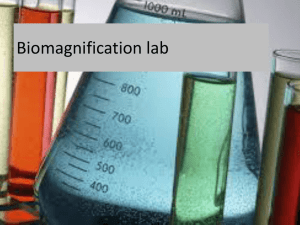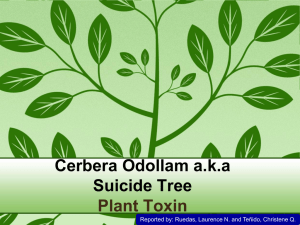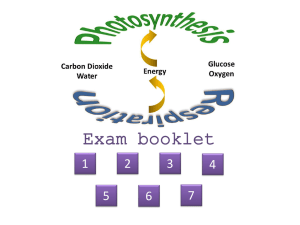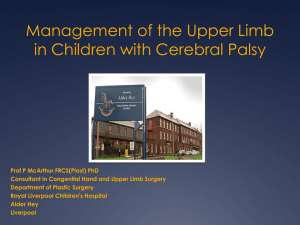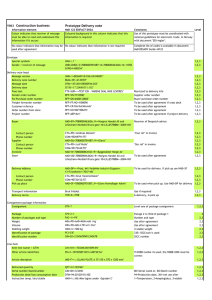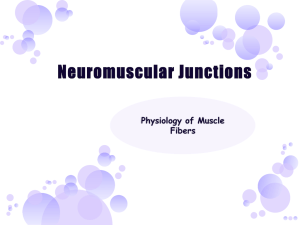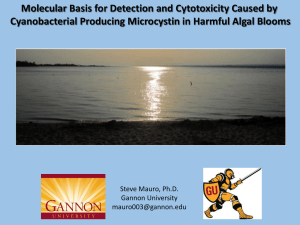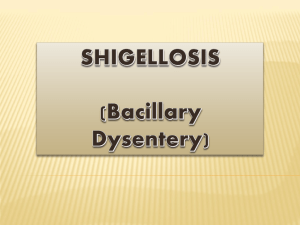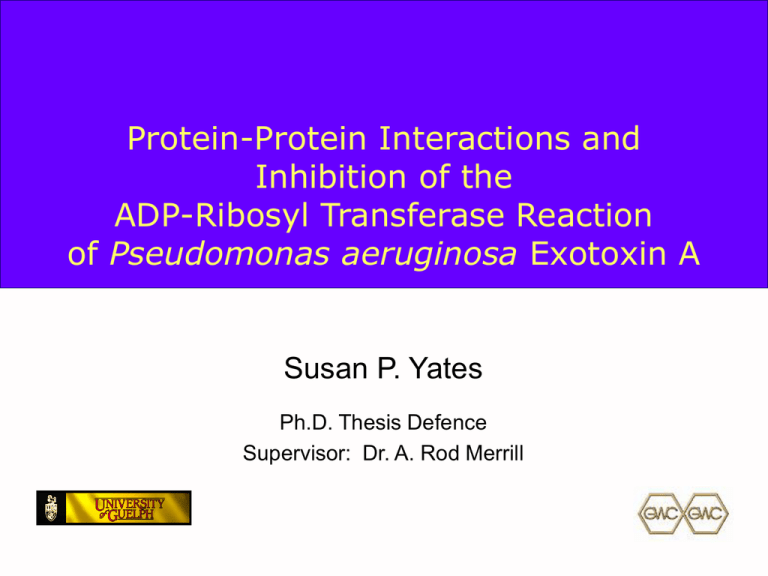
Protein-Protein Interactions and
Inhibition of the
ADP-Ribosyl Transferase Reaction
of Pseudomonas aeruginosa Exotoxin A
Susan P. Yates
Ph.D. Thesis Defence
Supervisor: Dr. A. Rod Merrill
Outline
Background
Research Objectives
Inhibition of the catalytic domain of exotoxin A
Interactions between the toxin and its protein substrate
Final Thoughts
Pseudomonas aeruginosa
Gram-negative rod-shaped
bacterium
Opportunistic pathogen
Exploits some break in the
host defenses to initiate
an infection
Cystic fibrosis, severe
burns, AIDS, cancer, etc.
Highly adaptable to new
environments
Resistant to many
antibiotics
Possesses a vast array of
virulence factors
Very complex pathogenesis
Virulence Factors
Pilus
Flagellum
Pseudomonas
aeruginosa
Alginate/Biofilm
LPS
Extracellular products
Rhamnolipid
Phospholipase C
Proteases
Siderophores
.Exotoxin A
Exotoxin A – The Virulence Factor
Exotoxin A (ETA) is the most potent virulence factor of
Pseudomonas aeruginosa
LD50 of 0.2 mg when injected intraperitoneally into a 18-gram
mouse
Biological effects
Extensive tissue damage
Promotes bacteria invasion
Interferes with function of the cellular immune system
May lead to systemic disease
Exotoxin A – The Enzyme
Member of mono-ADPribosyl transferase family
Other members include:
Diphtheria toxin, pertussis
toxin, cholera toxin, C3
exoenzyme, iota toxin
Ib
66 kDa single polypeptide
III
Catalytic
Three functional domains
Secreted as a proenzyme
Activated within the
eukaryotic cell through a
proteolytic event
II
Translocation
Ia
Receptor binding
(Wedekind et al., (2001) J. Mol. Biol. 314, 823)
Eukaryotic Elongation Factor 2 (eEF2)
Protein substrate for ETA
90 –110 kDa protein
GTPase superfamily
Important factor in the
elongation step of protein
synthesis
Covalent modification by ETA
produces ADP-ribosyl eEF2
(ADPR-eEF2)
G′
G
II
V
Prevents its participation in
protein translation
III
IV
Cell death
Diphthamide
(Jørgensen et al., (2003) Nat. Struc. Biol. 10, 379)
Function of eEF2
ADP-Ribosyl Transferase (ADPRT) Reaction
H2N
N
O
A -p h o s p h a te
N
NA D
N
+
N
H2C
O
O
O
O
P
P
O-
O
O
O-
O
N -p h o s p h a te
A -rib o s e
HO
H2N
OH
H
OH
HO
O
N
N
n ic o tin a m id e
N
N
H2C
O
O
O
O
P
P
O-
O
O-
O
H
A -p h o s p h a te
N
N
O
N -rib o s e
NH 2
-
STEP 1
NH2
+
N
CH2
CH2
O
C
H
+
H
d ip h th a m id e
re s id u e o f
eEF2
CH2
N -p h o s p h a te
A -rib o s e
N
HO
OH
HO
OH
o x a c a rb e n iu m io n
STEP 2
H2N
-H
NH
N -3
+
H2C
N (CH 3 ) 3
CH2 CH
O
+
H2N
N
N
N
N
O
H2C
O
O
O
P
P
O-
O
O-
CH2
O
O
OH
H
N
A -rib o s e
HO
O
NH
C
H
CH2
HO
N -rib o s e
A D P -rib o s yl - e E F 2
N
OH
+
H2C
N (CH 3 ) 3
CH2 CH
O
H2N
Catalytic Domain of ETA (PE24H)
-T A D
T yr-4 7 0
T yr-4 8 1
G lu -5 5 3
H is -4 4 0
(Li et al., (1996) PNAS 93, 6902)
Research Objectives – The Big Picture
General statement
Improve the understanding of the interactions between the
catalytic domain of ETA and both its substrates, eEF2 and NAD+
Long term research goals
Understand the detailed reaction mechanism for ETA
Knowledge-based approach to preventing the action of this toxin
Develop new strategies that target ETA to fight Pseudomonas
aeruginosa infections
Research Objectives – My Specific Projects
Part A: Interactions of the toxin with NAD+
1. Study of water-soluble inhibitors
2. Development of a NAD+-glycohydrolase assay
Part B: Toxin-eEF2 interactions
3. Physiological requirements for binding
4. Fluorescence-based approach to elucidate sites of contact
5. Fluorescence resonance energy transfer (FRET) distance study
PART A:
Interactions of the Toxin with NAD+
Project #1
STUDY OF WATER-SOLUBLE INHIBITORS
Yates, S.P., Taylor, P.L., Jørgensen, R., Ferraris,
D., Zhang, J., Andersen, G.R., and Merrill, A.R.
Biochem. J. (2005) 385:667-675.
Inhibition of PE24H
Previous work from our research group
Characterization of a series of small, non-polar competitive
inhibitors
Most potent inhibitor was NAP (1,8-napthalamide)
Model of NAP bound to catalytic domain of ETA
Lack of water-solubility limited the usefulness as potential
therapeutic drugs
Armstrong et al., (2002) J. Enzyme Inhib. Med. Chem. 17, 235
Aims of Study
Characterize a series of water-soluble compounds for their
inhibition against PE24H
Co-crystal structure of the inhibitor PJ34 with PE24H
The Inhibitors
Mimic nicotinamide
IC50 values ranged from
170 nM to 82.4 mM
T ricyclic L actam s – [6,6,6]-R in g S ystem
O
O
F
NH
GP-D, PJ34, GP-M
most potent
Hallmark of a good
inhibitor was a planar
hetero-ring
NH
N
N
N
N
NH
N
N
N
N
HN
N
N
O
O
O
H 3C
CH3
CH3
P J34
G P -L
N
CH3
H 3C
G P -G
G P -N
G P -M
T ricyclic L actam s – [5,6,7]-R in g S ystem
O
NH
NH
NH
N
O
O
O
O
O
O
NH
NH
NH
NH
N
N
NH
N
N
O
N
CH3
N
N
N
N
CH3
O
N
N
CH3
H 3C
G P -D
B icyclic L actam
G P -F
G P -H
G P -I
+
T etracyclic L actam
N A D A n alo g u e
O
O
O
NH2
NH
+
NH3 Cl
NH
N
+
NH2
O
-
F
O
O
SO 3 H
N
N
-
OH
O
N
P
O
O
O
O
OH
P
O
N
-
O
OH
5 -A IQ
G P -P
+
+
2’-F -ribo-N A D (F -N A D )
PJ34 – Further Characterized
Water-soluble phenanthridinone
derivative
O
IC50 = 280 nM
NH
Commercially available
Well-characterized compound
Studied in extensively in several
PARP related systems
NH
O
N
H 3C
CH3
Biochemical Characterization of PJ34
Binding affinity
KD is 820 54 nM
70x tighter binding to PE24H
compared to NAD+
F/ F max )
1.2
Fractional Saturation (
1.0
0.8
0.6
0.4
0.2
0.0
0
1000
2000
3000
4000
5000
[PJ34], nM
Competitive inhibitor
As [PJ34] increases, the KM
increases but the Vmax
remains unchanged
Ki = 140 nM determined
using both Dixon and
Lineweaver-Burk methods
1.0
50 mM -NAD
+
100 mM -NAD
+
0.8
200 mM -NAD
+
300 mM -NAD
+
0.7
500 mM -NAD
+
0.9
0.6
1/v 0, s/pmol
0.5
0.4
0.3
0.2
0.1
0.0
-0.1
-200
0
200
400
600
[PJ34], nM
800
1000
1200
Crystallization of PE24H-PJ34
Data
2.1 Å resolution
Refinement
R-factor = 21.3 %
Rfree-factor = 23.5 %
Hydrophobic Pocket and Active Site
Yates et al., (2005) Biochem. J. 385, 667
Interactions in the Active Site
3.1 Å
2.7 Å
2.5 Å
2.5 Å
Yates et al., (2005) Biochem. J. 385, 667
Similar Enzymes
Catalytic domain of ETA is functionally and structurally similar
to both mono-ADPRTs and PARPs
Diphtheria toxin (DT)
Mono-ADPRT and also catalyzes the ADP-ribosylation of eEF2
PARPs (Poly-(ADP-ribosyl) polymerases)
Catalyzes the covalent attachment of ADP-ribose units to
nuclear DNA-binding proteins
Taken from: Putt & Hergenrother (2004) Anal. Biochem.326, 78
Comparison to Other Active Sites
DT
DT structure:
Bell & Eisenberg, (1996)
Biochemistry 35, 1137
PARP
PARP structure:
Ruf et al., (1998)
Biochemistry 37, 3893
Findings for Project #1
Hetero-ring planarity important for inhibition
PJ34 is a competitive inhibitor
First report of a structure of a mono-ADPRT-inhibitor complex
Confirmed the hydrogen bonding of the lactam moiety to Gly-441
Planar compounds sandwich better into the nicotinamide-binding
pocket than more flexible compounds
Similarities and differences between bacterial toxins and
PARP
Exploit the differences to target one enzyme over the other
PART A:
Interactions of the Toxin with NAD+
Project #2
DEVELOPMENT OF A
NAD+-GLYCOHYDROLASE ASSAY
Yates, S.P., and Merrill, A.R. Anal. Biochem. (2005) in press.
NAD+-Glycohydrolase Activity
H2N
N
N
O
O
O
H2C
P
P
CH2
O
O
O
O
O
O- ON
N
HO
OH
NH2
H
OH
HO
NAD+
+
N
O
STEP 1
H2N
N
N
O
HO
NH2
N
nicotinamide
N
N
-
H2C
O
O
P
P
CH2
O
O
O
O
O- O-
OH
+
H
O H- + H+
HO
OH
oxacarbenium ion
H2O
H2N
STEP 2 - H+
N
N
O
O
H2C
P
P CH2 O
O
O
O
O
O- ON
N
HO
OH
HO
ADP-ribose
H
OH
OH
F-NAD+
Initial inhibitor study showed that IC50 value is 82.4 7.4 mM
+
Binding affinity to toxin similar to NAD
O
1.0
F i/ F max )
NAD+ KD = 53 2 mM
F-NAD+ KD = 33 1 mM
NH2
N
+
NH2
O
F
O
N
N
-
OH
O
N
P
O
O
O
-
O
0.8
0.6
0.4
0.2
+
OH
P
O
N
Fractional Saturation (
F-NAD
+
NAD
0.0
O
OH
0
200
400
+
600
+
[NAD or F-NAD ], mM
800
1000
N
O
N
N
H 2C
O
O
P
O
P
HO
CH 2
O
O
HO
O-
N -rib o s e
OH
-+
H
A D P -rib o s e
+
HO
OH
o x a c a rb e n iu m io n
Is F-NAD+ a competing Hsubstrate
or a competitive inhibitor?
O
A -rib o s e
2
B.
Is the C-N bond broken?
STEP 2
H2N
-H
H 2N
+
N
N
OH
-p h o s p h a te
N
O HPLC-based
O
Develop
an
N
CH
N
H 2C
Why?
O
O
P
O-
O
P
O-
2
O
O
HO
O
-p h o s p h a te
N
O
O
N
NAD+-glycohydrolase
N
H
O
H2C
O
P
O-
A -rib o s e
OH
-p h o s p h a te
A -rib o s e
HO
OH uses
Fluorometric
assay
OH
-NAD+
HO
O
P
O-
assay
CH
O
OH
A D P -rib o s e
F-NAD+ lacks
O
-p h o s p h a te
O
N
O
H2C
A -rib o s e
HO
H
F
HO
this structural feature
N
N
O
2 '-F - N -rib o s e
H 2N
N
NH 2
+
Contains a etheno bridge which gives rise to
its fluorescence
F -NAD
2
+
N
-p h o s p h a te
N -rib o s e
.
OH
H
-p h o s p h a te
OH
HO
+
Aims of Study
O-
OH
-p h o s p h a te
A -rib o s e
O
O
P
O-
O
O-
+
O
CH 2
N
O
+
N
H
HO
F
O
-p h o s p h a te
NH 2
N
N
O
-p h o s p h a te
OH
C.
N
O
P
NH
H 2C
-A -rib o s e
HO
O
O
O
P
P
O-
O
O-
O
-p h o s p h a te
OH
HO
2 '-F - N -rib o s e
F -NAD
+
CH 2
N
O
H
OH
N -rib o s e
+
-N A D
+
NH 2
Reaction and Sample Preparation
Samples (25 mL) taken
at t = 0 to 4 hrs
Reaction Setup
Toxin + NAD+ (250 mL)
Sampling
Inhibit Reaction
Load to Spin Column
Add 75 mL
Mobile Phase
(with internal standard)
Toxin Removed
Chelating Sepharose
Spin Column
PE24H
bound
to resin
Flow-Through
ready for HPLC –
contains no protein
HPLC Instrumentation Setup
Inject sample via sample loop
150 mm
Precolumn
C18 column – reverse phase
Detector at 259 nm
Mobile phase: 20 mM NaHPO4, pH 5.5: acetonitrile (100:5 v/v %)
4.6 mm
HPLC and Analysis – Rate Determination
0.10
NAD
+
0.06
0.04
ADPR
0.02
PABA
nicotinamide
0.00
0
2
4
6
0.6
0.4
0.2
0.0
0
8
100
200
300
Time Course Plot
250
200
150
Rate = 55 3 mM
nicotinamide produced
per hour
100
50
0
1
2
Time (hours)
400
500
Nicotinamide Standard Curve
Chromatogram
0
300
pmoles of nicotinamide
Retention Time (minutes)
nicotinamide produced (mM)
Absorption Units
0.08
peak area of nicotinamide
calibrated with the internal standard
PABA
0.8
+
3
4
Rate of Hydrolysis of F-NAD+
Mathematically
deconvoluted ADPR peak
from NAD+ or
FNAD+ peak
0.06
0 hours
0.05
F-NAD
Absorption Units
Visual inspection of
chromatograms shows the
peak area for ADPR
increasing
+
0.04
0.03
0.02
0.01
ADPR
PABA
nicotinamide
0.00
0
2
4
6
8
Retention Time (minutes)
Hydrolysis of F-NAD+ is
0.2% rate of NAD+
0.06
48 hours
0.05
F-NAD
Absorption Units
+
0.04
0.03
0.02
0.01
ADPR
PABA
nicotinamide
0.00
0
2
4
6
Retention Time (minutes)
8
Findings for Project #2
HPLC-based NAD+-glycohydrolase assay developed
Addition of spin column step allows quick removal of protein
F-NAD+ binds to the enzyme but not readily hydrolyzed
What does fluorine substitution at 2'-OH position do?
Disrupts hydrogen bond between Glu-553 and 2'-OH position
This hydrogen bond important for bond breakage
Cause nicotinamide leaving group to depart slower
Fluorine substituent may destabilize cationic intermediate
PART B:
Toxin-eEF2 Interactions
Project #3
PHYSIOLOGICAL REQUIREMENTS FOR BINDING
Loop
Yates, S.P., and Merrill, A.R. J. Biol. Chem. (2001) 276:35029-35036.
pH and Guanyl nucleotide
Armstrong, S., Yates, S.P., and Merrill, A.R. J. Biol. Chem. (2002) 277:46669-46675.
ADPR-eEF2
Jørgensen, R., Yates, S.P., Teal, D.J., Nilsson, J., Prentice, G.A., Merrill, A.R., and
Andersen, G.R.
J. Biol. Chem. (2004) 279:45919-45925.
Aims of Study
Investigate the conditions required for toxin-eEF2 interaction
Effect of pH
Effect of bound guanyl nucleotides on eEF2
Effect of ADP-ribosylation of eEF2
Functional role of a surface-exposed loop near the active site
FRET-based eEF2 Binding Assay
Fluorescence Resonance
Energy Transfer (FRET)
Transfer of excitation energy
from a donor fluorophore to a
an acceptor fluorophore
through non-radiative dipoledipole interactions
Criteria
Donor and acceptor in close
proximity
Acceptor absorption
overlaps with fluorescence
emission of donor
Dipole-dipole interactions
are parallel
Donor
Fluorescence
Acceptor
Absorption
Wavelength ()
Donor fluorophore
PE24H labelled with
IAEDANS (PE24H-AEDANS)
Acceptor fluorophore
eEF2 labelled with
fluorescein (eEF2-AF)
Effect of pH on eEF2 Binding to Toxin
Optimum eEF2 binding at
pH 7.8
Two distinct pKa values
pH profiles for eEF2
binding and catalysis very
similar
eEF2 binding may be
responsible for pH
dependence observed in
catalysis
7.0
6.0
-1
5
Acidic pKa = 6.3
His residue
Alkaline pKa = 9.3
Tyr residue
8.0
KA (x 10 M )
9.0
5.0
4.0
3.0
2.0
1.0
0.0
4
6
8
pH
10
12
Effect of Guanyl Nucleotides
eEF2 is a member of the GTPase superfamily
Does the toxin require a specific eEF2 conformation for binding?
eEF2 with non-hydrolyzable GTP/GDP analogues bound
F i/F max )
1.0
0.8
eE F2 substrate
N ative-absence o f bo und nucletides
Fractional Saturation (
0.6
G D P - -S bo und
G T P --S bo und
R elative A D P R T
100 9
102 4
92 10
a
0.4
0.2
eEF2-AF
GTP--S-eEF2-AF
GDP- -S-eEF2-AF
0.0
0
1000
2000
3000
4000
5000
6000
[eEF2-AF], nM
Toxin does not prefer a specific state of eEF2 for either
binding or catalytic function
Interaction of ADPR-eEF2 with Toxin
ADPR-eEF2 maintained the
ability to bind toxin
Active site of toxin can
accommodate the bulky
ADP-ribose group
Structures of both eEF2 and
ADPR-eEF2 recently solved
No major conformational
changes induced after ADPribosylation
Fractional Saturation (
F i/ F max )
1.0
0.8
0.6
0.4
0.2
eEF2-AF
ADPR-eEF2-AF
0.0
0
1000
2000
3000
[eEF2-AF] or [ADPR-eEF2-AF], nM
4000
Characterization of a Loop in ETA
History of Loop C
Residues 483-490
Functional removal
-T A D
T yr-4 7 0
T yr-4 8 1
G lu -5 5 3
H is -4 4 0
Alanine-scanning mutagenesis
Decreases activity
significantly (1.8 x 10+4-fold)
Retains ability to bind NAD+
near wild-type levels
Loop C
Some mutant proteins
exhibited reduced activity
KD and KM for NAD+ similar to
wild-type
What is the role of this Loop?
Catalytic or eEF2 substrate
binding?
(Li et al., (1996) PNAS 93, 6902)
Determination of KM and KD for eEF2
R elative k c a t
W ild -type
Q 483A
D 484A
Q 485A
D 488A
1.00
0.11
0.07
0.69
0.17
0.05
0.01
0.003
0.01
0.01
R elative
K M (eE F2 )
1.00
1.02
2.19
1.01
2.06
0.12
0.09
0.21
0.05
0.13
R elative specificity
co nstant
Alanine-scanning mutants
1.00
0.11
0.03
0.68
0.08
0.07
0.01 M
0.002
0.02
0.001
K for eEF2 unaffected
Enzyme rate (kcat) is affected
pG-Loop C mutant protein
Each residue within Loop C
replaced with glycine
Functional removal of loop
Retained ability to associate
with eEF2 at normal levels
Fractional Saturation (Fi/Fmax)
1.0
0.8
0.6
0.4
0.2
wild-type PE24H
pG-Loop-C PE24H
0.0
0
1000
2000
3000
[eEF2-AF], (nM)
Loop is a catalytic element
May modulate the transferase activity of the toxin
4000
5000
Findings for Project #3
Toxin-eEF2 association is pH-dependent
Correlates to that observed for catalytic function
GTP or GDP bound to eEF2 did not affect it as a protein
substrate
Structurally the diphthamide and guanyl nucleotide binding site
are quite distant
No direct coupling of sites
Toxin maintains the ability to associate with eEF2 after its
ADP-ribosylation
Loop C is important for catalysis
May stabilize the transition state structure during the catalytic
reaction
PART B:
Toxin-eEF2 Interactions
Project #5
FLUORESCENCE-BASED APPROACH TO
ELUCIDATE SITES OF CONTACT
Yates, S.P., and Merrill, A.R. Biochem. J. (2004) 379:563-572.
Aim of Study
Identify contact sites between eEF2 and PE24H
This protein-protein interaction is poorly characterized
Two extreme models are possible
Minimal Contact Model
Maximum Contact Model
PE24H
eEF2
PE24H
Experimental Approach
Single cysteine residues introduced into PE24H at 21 defined
surface sites and labelled with the fluorophore, IAEDANS
O
A la -5 1 9
IAEDANS
G ly -5 2 5
NHCH2CH2NH C
I
CH2
G ly -5 4 9
G ln -6 0 3
S er-5 1 5
G lu -4 8 6
..
A la -4 7 6
HS
A rg -4 9 0
T h r-5 5 4
S er-5 0 7
T h r-4 4 2
CH2
PROTEIN
SO3H
S er-4 5 9
-T A D
S er-5 8 5
T h r-5 6 4
A sn -5 7 7
S er-4 1 0
G ln -5 9 2
S er-4 4 9
S er-4 0 8
O
G ln -4 1 5
NHCH2CH2NH C
CH2
S
CH2
PROTEIN
G ln -4 2 8
Protein adduct
(Li et al., (1996) PNAS 93, 6902)
+
HI
SO3H
Experimental Approach
Fluorescence studies performed in the presence and
absence of eEF2
Fluorescence wavelength emission maxima (em,max)
Fluorescence lifetime
Acrylamide quenching
Fluorescence em,max and Lifetime
0 (ns)
Protein adduct
em,max (nm)
– eEF2
+ eEF2
– eEF2
+ eEF2
1
S408C
13.8 0.4
13.6 0.5
481
481
2
S410C
14.4 0.1
14.5 0.2
479
479
3
Q415C
14.3 0.3
13.9 0.3
478
479
4
Q428C
15.9 0.5
14.7 0.1
478
479
5
T442C
16.9 0.5
16.8 0.4
471
472
6
S449C
15.2 0.1
15.7 0.9
473
477
7
S459C
14.4 0.5
13.9 0.5
479
480
8
A476C
15.9 0.2
15.6 0.8
478
478
9
E486C
14.9 0.1
14.6 0.6
478
479
10
R490C
12.0 0.5
11.7 0.3
483
483
11
S507C
13.2 0.2
13.7 0.4
482
481
12
S515C
16.0 0.2
15.4 0.3
473
476
13
A519C
15.7 0.1
16.9 0.1
479
478
14
G525C
13.4 0.1
13.4 0.3
481
481
15
G549C
15.5 0.4
15.8 0.2
480
479
16
T554C
15.3 0.1
15.9 0.8
478
477
17
T564C
16.7 0.3
16.5 0.2
474
475
18
N577C
12.7 0.1
12.4 0.4
482
482
19
S585C
14.0 0.2
14.2 0.6
481
481
20
Q592C
15.2 0.4
14.9 0.6
478
479
21
Q603C
14.2 0.1
14.0 0.7
481
482
Acrylamide Quenching
Measure the ability of acrylamide to
quench the fluorescence of
IAEDANS probe attached to PE24H
F0/F
Acrylamide is a water-soluble, nonionic quencher
The more accessible the probe is to
acrylamide, the more quenching is
observed
Determine the bimolecular
quenching constant (kq) in the
presence and absence of eEF2
using the Stern-Volmer equation
kq is the rate of collisions with the
quencher that result in deactivation
of excited state of the fluorophore
1
[Q]
F0
F
K SV [acrylamide ] + 1
K SV 0 k q
Acrylamide Quenching
9
-1 -1
kq (x 10 M s )
– eEF2
+ eEF2
1
S408C
1.03 0.02
0.37 0.01
2
S410C
1.29 0.01
0.36 0.01
3
Q415C
1.28 0.04
0.73 0.01
4
Q428C
0.86 0.03
0.54 0.01
5.0
5
T442C
0.56 0.02
0.20 0.01
4.5
6
S449C
0.60 0.02
0.27 0.01
7
S459C
0.94 0.03
0.42 0.02
8
A476C
0.89 0.03
0.58 0.01
9
E486C
1.29 0.04
0.48 0.02
10
R490C
1.27 0.04
0.70 0.02
11
S507C
0.80 0.02
0.33 0.01
12
S515C
0.55 0.03
0.41 0.01
13
A519C
1.23 0.04
0.61 0.02
14
G525C
0.96 0.01
0.75 0.02
1.5
15
G549C
0.65 0.03
0.35 0.01
1.0
16
T554C
0.88 0.04
0.16 0.01
408
410
415
428
442
449
459
476
486
490
507
515
519
525
549
554
564
577
585
592
603
Protein adduct
17
T564C
0.50 0.02
0.27 0.01
Residue Number
18
N577C
1.10 0.04
0.74 0.01
19
S585C
0.90 0.02
0.59 0.01
20
Q592C
1.42 0.02
0.79 0.01
21
Q603C
0.68 0.02
0.39 0.01
6.0
*
k q(- eEF2) / k q(+ eEF2)
5.5
4.0
3.5
3.0
2.5
50%
2.0
Crude Model of PE24H-eEF2 Complex
Potential eEF2 contact sites
on PE24H
Minimal contact between
proteins
Diphthamide residue on
eEF2 positioned near
scissile glycosidic bond of
NAD+ in active site
Domain IVIV
Domain
of
of eEF2
eEF2
diphthamide
diphthamide
519
3
486
7
459
4
554
442
449
2
507
1
5
6
410
8
408
9
PE24H
PE24H
(Li et al., (1996) PNAS 93, 6902;
Jørgensen et al., (2003) Nat. Struc. Biol. 10,379)
Findings for Project #4
Fluorescence em,max and lifetime suggested minimal contact
Probes near active site or catalytic loop showed greatest
change in acrylamide quenching after eEF2 binding
No large changes observed after eEF2 complexation
Other locations showed smaller changes in kq
A crude toxin-eEF2 model was proposed
Contact between PE24H and eEF2 is minimal
PART B:
Toxin-eEF2 Interactions
Project #5
FRET DISTANCE STUDY
Aim of Study
Better define the proposed minimal contact model
Measure the distances between selected residues in PE24H to
eEF2 using FRET
Design and create recombinant mutant proteins of eEF2 to serve as
the acceptor fluorophore reference
Mutant eEF2 Proteins – Selection
Introduce a cysteine into domain IV
at a defined location to conjugate
the fluorescein probe
Thr-574 and Thr-812 chosen sites
to mutate
Non-conserved residues
Surface exposed side chains
Estimated that these residues will
be an ideal distance to PE24H
Thr-812
Thr-574
Diphthamide
(Jørgensen et al., (2003) Nat. Struc. Biol. 10,379)
Mutant eEF2 Proteins - Creation
Site-directed mutagenesis to create desired mutation
Introduce plasmid into Saccharomyces cerevisiae
Select for strain expressing the recombinant mutant eEF2
His-tag purification
T812C-yeEF2H protein is unstable
T574C-yeEF2H purifies at levels similar to wild-type
FRET Approach
PE24H-AEDANS (donor)
eEF2-AF (acceptor)
Calculate distance between donor
and acceptor using a series of
equations
E 1
Wavelength ( )
R0 9.8 10 J QD n
R R0 E
J
FDA
FD
3
Donor
Fluorescence
Acceptor
Absorption
2
1
1
1/ 6
4 1/ 6
Å
FRET between Toxin and T574C-eEF2
PE24HAEDANS
Adducts
S410C
E486C
R490C
S507C
G525C
N577C
S585C
Q592C
Quantum
Yield
0.41
0.43
0.31
0.33
0.33
0.33
0.40
0.38
Overlap
Integral,
-13
3
-1
J (x 10 cm M )
Förster
Distance
R0 (Å)
1.72372
1.72956
1.80256
1.78248
1.75769
47.0
47.4
45.2
45.7
45.6
45.6
47.3
47.0
1.75784
1.83424
1.82695
Efficiency
(%)
40.9
32.0
24.3
30.3
28.3
22.9
27.3
49.3
Estimated
Distance
R (Å)
49.9
53.8
54.7
52.5
53.3
55.8
55.7
47.2
Anisotropy
Measures local rotational motion of the IAEDANS probe on
PE24H before and after eEF2 complexation
Do any of the probes have significantly restricted mobility after
eEF2 binds?
Can we assume that 2 is two-thirds?
P E 24H -A E D A N S
A dducts
S 410C
E 486C
R 490C
S 507C
G 525C
N 577C
S 585C
Q 592C
(– ) yeE F2
0.086
0.106
0.066
0.075
0.079
0.074
0.078
0.087
0.001
0.002
0.003
0.003
0.002
0.002
0.004
0.002
(+ ) yeE F2
%
increase
7.0
6.0
17.1
32.3
18.4
45.0
25.9
32.5
0.093
0.113
0.080
0.110
0.097
0.135
0.106
0.129
0.001
0.001
0.003
0.001
0.001
0.001
0.001
0.001
N577C-AEDANS
After eEF2 associates this probe displays significantly hindered
mobility
Development of FRET Distance Model
Important to remember
T574C-AF
The apparent distances have
10-20% uncertainty
Length of linker for probes
contributes to distance
Cys-AEDANS
Cys-AF
585
525
Efficiency depends on the
orientation of the probes
Position fluorescein probe on
eEF2 in three-dimensional
space to best satisfy calculated
distances
577
592
486
490
507
410
(Li et al., (1996) PNAS 93, 6902)
Comparison to X-ray Structure of Complex
Does this FRET model agree with the recently solved toxineEF2 structure?
T 5 7 4 C -A F
D ip h
577
592
525
585
486
490
410
507
(Jørgensen et al., manuscript in preparation)
Effect of -TAD (An NAD+-Analogue)
585
525
577
592
486
490
507
410
(Li et al., (1996) PNAS 93, 6902)
PE24H-AEDANS
Adducts
G525C - -TAD
G525C + -TAD
N577C - -TAD
N577C + -TAD
Efficiency
(%)
28.3
41.6
22.9
31.1
Estimated
Distance
R (Å)
53.3
48.5
55.8
52.3
Findings for Project #5
FRET-based model and X-ray structure agree within the error
of the technique
N577C-AEDANS is the exception
Anisotropy values suggests probe restriction
Distances shorten between the toxin and eEF2 when -TAD is
bound in the complex
Earlier Crude Model vs. X-ray Structure
eEF2
(from Project #4)
PE24H
PE24H
(Jørgensen et al., manuscript in preparation)
Final Thoughts
Improved understanding of structural features important for
inhibition
Hetero-ring planarity
X-ray structure of inhibitor with toxin
Able to distinguish a substrate from an inhibitor
HPLC-based NAD+-glycohydrolase assay allows direct
observation of products
Toxin highly adaptable
Ability to bind eEF2 and its many forms (GTP/GDP, ADPR)
pH dependence for catalysis now assigned to eEF2 binding
Minimal contact model best describes toxin-eEF2 interactions
FRET distance model correlates with X-ray structure
Acknowledgements
Supervisor
Dr. Rod Merrill
Merrill Research Group
Trish Taylor, Gerry Prentice,
Abdi Musse
Univ. of Aarhus, Denmark
Dr. Gregers R. Andersen
René Jørgensen
Guilford Pharmaceuticals
Dr. Jie Zhang
Dr. Dana Ferraris
Advisory Committee
Dr. Joe Lam
Dr. Bob Keates
Dr. John Honek, Univ. of Waterloo
Examination Committee
Dr. Dan Thomas
Dr. Joe Lam
Dr. Michael Palmer, Univ. of Waterloo
Dr. Jean Gariépy, Univ. of Toronto
Univ. of California, San Francisco
Dr. Norman Oppenheimer
University of Guelph
Dr. Adrian Schwan
Financial Support
Canadian Cystic Fibrosis Foundation
PhD CCFF Studentship
Canadian Institutes of Health Research
Family and Friends
Parents
Matthew Davidson
My PhD Journey!

